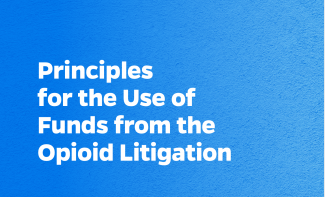
Balancing Act for States Use of Opioid Settlement Funds: Saving Lives Now and Investing in the Future
We know that the COVID-19 pandemic has exacerbated the addiction crisis, with new data reporting the highest number of fatal overdoses every recorded, exceeding 107,000 overdose deaths in 2021. The need for a stronger, more focused approach to saving lives is more important than ever, as America is facing the single worst drug crisis in its history.
As reported this week, the multi-district litigation against the opioid manufacturers and distributors is expected to be settled imminently.
States and counties will soon have billions of dollars to invest in science-based programs to prevent and treat addiction, and to help their constituents recover. It may seem overwhelming to states, particularly if they have not set up processes yet on how to spend the settlement dollars.
To help guide states in this process, we encourage the adoption of all five guiding principles for use of opioid litigation funds.
We advise focusing on 3 key steps to get started: set up a dedicated fund, conduct a statewide needs assessment, and issue grants to science-based programs and initiatives.
We are urging states to start with setting up a dedicated fund so the settlement monies can only be spent on substance use services and programs. This might seem like a given especially since the legal documents have “allowable uses” within their agreements; however, the states must set up dedicated processes or it will be easy to spend these dollars on services other than on substance use disorder.
To assess where states have current challenges or gaps, we advise investing in a statewide evaluation or needs assessment to determine areas of critical importance to focus abatement efforts. If such an assessment has been done in the state in the last year, lean on that report to focus efforts. All efforts should be made to align these strategies with existing programs or strategies coordinated out of state agencies and/or Governors' offices.
Finally, whichever programs and initiatives states prioritize, we need to underscore the importance of using science to guide spending. At this point in the overdose epidemic, researchers and clinicians have built a substantial body of science demonstrating what works and what does not. States and counties should direct funds toward science-based programs, removing policies that block adoption of programs that work, and building capacity for further robust data collection.
Addiction contributes to the deaths of tens of thousands of Americans each year, many of which are preventable.
To reduce this burden, much more action must be taken. Ensuring the funds received from opioid-related litigation are used to address these issues in a strategic and meaningful way is a good start.




